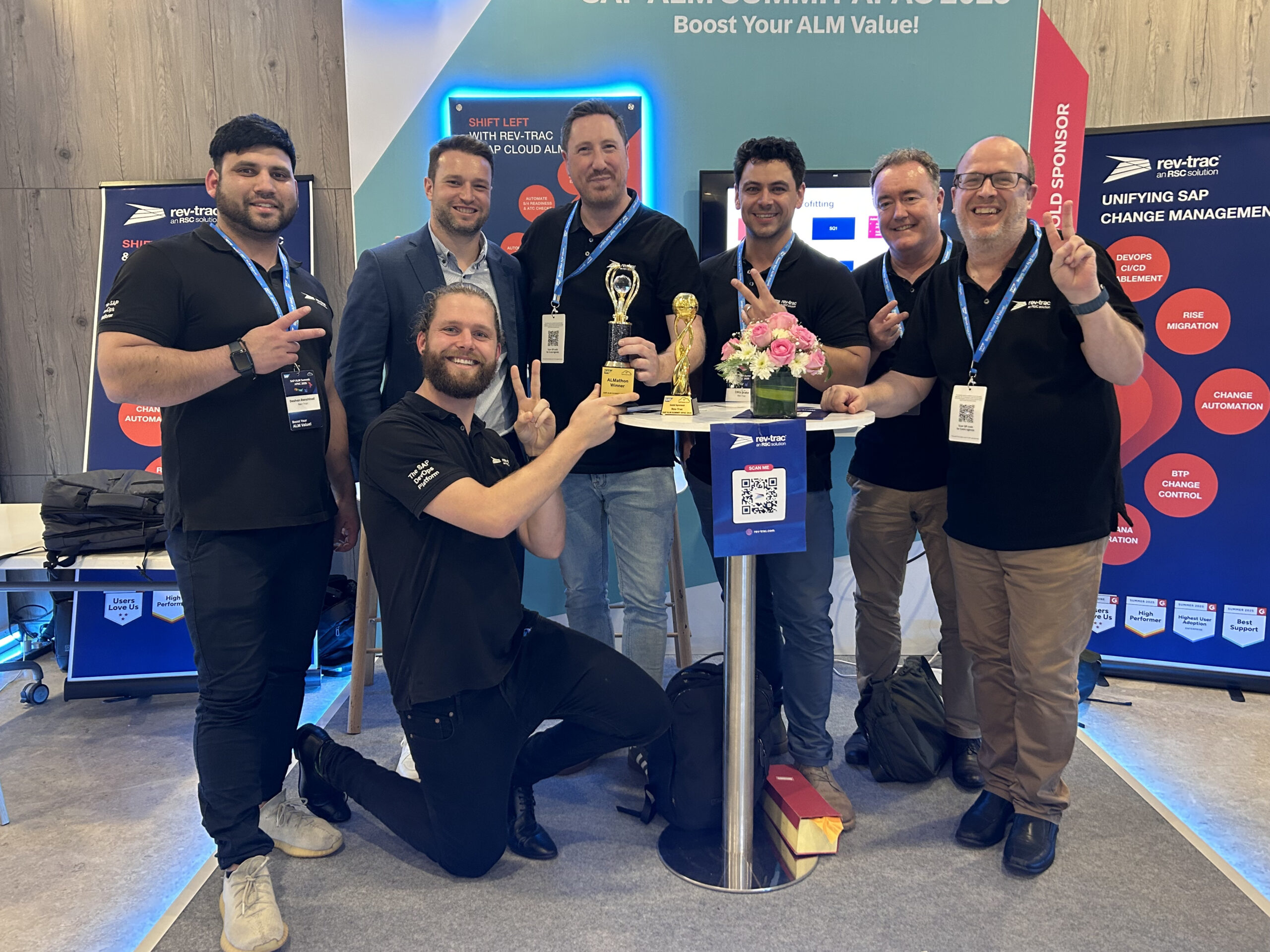TL;DR
- SAP ALM Summit APAC was full-on with three jam-packed days of keynotes, break-out sessions, and hands-on workshops
- The event its was insightful, interactive, and engaging
- The future is AI and autonomous Cloud ALM
- Joule-powered automation and insights
Introduction
Recently, I had the opportunity to attend the SAP ALM Summit APAC in Bengaluru, India, for the first time. Rev-Trac again had the privilege of being a (Gold) sponsor for the event, which brings together customers, partners, and experts to explore SAP’s latest innovations in ALM. Being on-site at SAP Labs India was an excellent opportunity to build on my knowledge of SAP Cloud ALM and gain real-world insights into the challenges and questions SAP users have in shifting to the Cloud.
There was clear excitement from the SAP team about its AI-first approach for ALM. SAP Cloud is on the journey to becoming an intelligent, autonomous platform, a transformation driven by enabling AI capabilities in Cloud ALM. SAP’s message was clear: AI in Cloud ALM enhances efficiencies, accuracy, and delivers greater business value. Cloud ALM is more than a tool; it’s the cornerstone of your digital transformation.
While AI-driven ALM was the focus of many conversations, the Summit was more than a showcase for SAP’s Business AI and its innovations and plans in generative and agentic AI with Joule at the heart of the intelligent insights.
Cloud ALM’s deeper integrations with other SAP and partner solutions were another focus. Talk centred on the integrated toolchain, which SAP positions as a unified solution in the RISE with SAP methodology. Leveraging this toolchain can help to accelerate and de-risk your transformation to the Cloud-first SAP Business Suite, which combines applications, data, and AI capabilities to drive continuous innovation.
SAP ALM Summit APAC: Key takeaways and insights
Autonomous Cloud ALM:
SAP’s vision for the future state of Cloud ALM. In this scenario, SAP Cloud ALM leverages AI to automatically identify and analyze problems (before they happen), resolve the issue, and automate processes and workflows. With AI-powered insights and functionality, Cloud ALM is becoming a proactive platform rather than a reactive one. It opens the door to SAP’s goal of a self-healing platform that adapts based on real-time conditions.
SAP integrated toolchain:
With SAP’s focus on the Cloud – many of its newest innovations are Cloud-only and the end of support for SolMan fast approaching – it’s no surprise that RISE with SAP dominated many conversations.
A core component of the RISE with SAP methodology is the integrated toolchain, a connected set of SAP and partner tools that support end-to-end transformation and maintain system integrity. Cloud ALM is the central hub of the toolchain. Acting as the orchestration engine, it integrates with tools such as SAP Signavio, SAP LeanIX, WalkMe, Syniti, Tricentis, etc. to manage your project from start to go-live, while helping you maintain a clean core.
Solman Sunset and Cloud ALM transition:
As Cloud ALM continues to mature, a recurring theme at the Summit was the transition from SolMan to Cloud ALM. How do you transition? When should you transition?
SAP’s advice: start now. But it recommends avoiding a big bang approach and adopting Cloud ALM at your own pace. Complete ongoing projects using SolMan, an S/4HANA migration for instance. In the meantime, adopt Cloud ALM for Operations and Services, while utilizing SolMan for RISE with SAP implementations where more advanced change and release management needs are a priority, for example. Cloud ALM and SolMan can run in parallel. For many organizations, this is essential until Cloud ALM matures to a point where it can functionally replace SolMan. Stay updated on SAP’s evolving roadmap for new functionalities.
Migration discussions resonated with delegates. Many organizations still rely on SolMan’s ChaRM to manage change and deployment because the required functionality is not available in Cloud ALM. Retrofit, governance, and compliance were among the most in-demand capabilities from delegates.
SAP announced that retrofit is coming with Cross System Object Lock (CSOL) foundation for retrofit and support for automatic retrofit planned for Q4 2025, and other innovations in 2026. While this was welcomed, customers with large or complex landscapes and advanced needs will have to depend on SAP partners for features that they require now and (possibly) into the future until the capabilities mature. Rev-Trac Platinum’s retrofit capability for Cloud ALM is one such option. And it’s readily available today to help fill functionality gaps.
Shift left the shortcut to success
Cloud ALM and related methodologies, a trend throughout the event was Clean Core and a successful transformation, which can be broken into multiple stages.
Rev-Trac’s Head of Product and Strategy, Chris Drake, explored this in his keynote, “The Secret to Transformation Success?” Shifting Left with Cloud ALM and Rev-Trac”. He emphasized that shifting left (using Rev-Trac and Cloud ALM) and embedding safety, compliance, and S/4HANA readiness checks early in the change cycle dramatically improves transformation success rates.
The Bottom Line
As SAP continues to roll out new capabilities in SAP Cloud ALM, it’s important to stay up to date with what’s coming and when it will be available. In the meantime, if you need functionality that isn’t yet delivered, partners can help bridge the gap. That’s precisely what Rev-Trac offers in the change management space with our advanced SAP automation platform, Rev-Trac Platinum.

